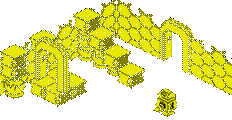Secret Weapons of Commodore - the Educator64
Intending to use pictures or text from this page? Please read this notice.
Last modify September 1998.
.jpg Image of the Educator 64 (21K, courtesy Marko Märkelä,
Andreas Boose, George Page)
.gif Image of the Educator 64 (21K)
Complete Set of Views of the Educator 64 (courtesy Moise Sunda, .jpg)
Front (51K) | Inside Board (81K) | Keyboard (67K) | Keyboard Labels:
Left (70K), Center (65K), Right (68K) | Model # Tag (38K) | Screenshot
(54K) | Side (47K) | Complete View (66K)
Screenshots of the 4064 (I created this with Frodo v4.1 and the 4064
Kernal ROM)
Startup Screen (1K)
4064 Kernal ROM Dump (courtesy Marko)
aka 4064, PET 64
Introduced Late 1982
Hardware Identical to the 64. Some models had an integrated monitor
(like the one in the image) and were in fact 64s packaged in PET casings;
others were in the standard case; the 4064 models, however, had slight
modifications made to Kernal ROM to make the startup colours black and
white (see Graphics and Sound and Comments), and the familiar "38911
BASIC BYTES FREE" message was for some reason eliminated (this
is the ROM version above, and the one in the screenshot). However, I
have also encountered models that simply look like regular 64s. In fact,
Moise reports that his unit is nothing more than an early 64 motherboard
with an audio amplifier connected to it and a headphone jack on the
front (clearly visible in the photograph of the unit's front). There
is even a reset button next to the amp's volume control.
Graphics and Sound As mentioned, some of the PET-(en)cased Educators
(4064 series) displayed black and white only; sound, colour and sprites
were disabled (actually made invisible, see Comments); however, this
was a software change, not new or missing chips. The Educators in the
standard breadbox case supported the regular colour capabilities and
sound, according to Andrew Davie, and so did many in the PET casings.
Eventual Fate Released, but not a strong seller.
Comments
The fact that the 4064 and likeminded machines were not strong sellers
didn't matter anyway, since most of them were refurbished 64 boards
that had been sent back to Commodore. Commodore fixed them, crammed
them into whatever case they had available, and shipped it out to schools
at a bargain rate, hence the name. Commodore's line of public domain
educational software was apparently targetted at the Educator, and may
have even been bundled with it (unconfirmed). According to Travis Little,
the Educator 64's design was at least in part the idea of the New York
(State) Department of Education. School officials were dismayed at how
easily the breadbox units could be stolen (in fact, quite a few disappeared
from schools, and they fit very neatly in students' knapsacks), so Commodore
presented the old PET cases as an inexpensive stopgap solution. (Apples,
of course, had the edge for theft-proofing. Just try to stick a //e
in your backpack, even without the security cable. :-)
Moise's and CCC's Educators all come up with the colour screen if you hook them up to a colour monitor, and all of them run C64 software without comment and with standard graphics and sound. Therefore, there must be two Kernal versions: the stock 64 Kernal (in Moise's model) and the 4064 Kernal available for download above, which sets all sprite, border and background colours to black during IRQs and has the new message. (It will let you change the cursor colour, however.) You can get colours back if you type POKE646,PEEK(646)OR128, which causes the Kernal to release its control. Hit RUN/STOP-RESTORE, though, and it goes back to its old tricks. On a monochrome monitor, since you can only see luminance, this doesn't make a difference, but this allows you to use a 4064 normally with a colour monitor if you are so blessed.









